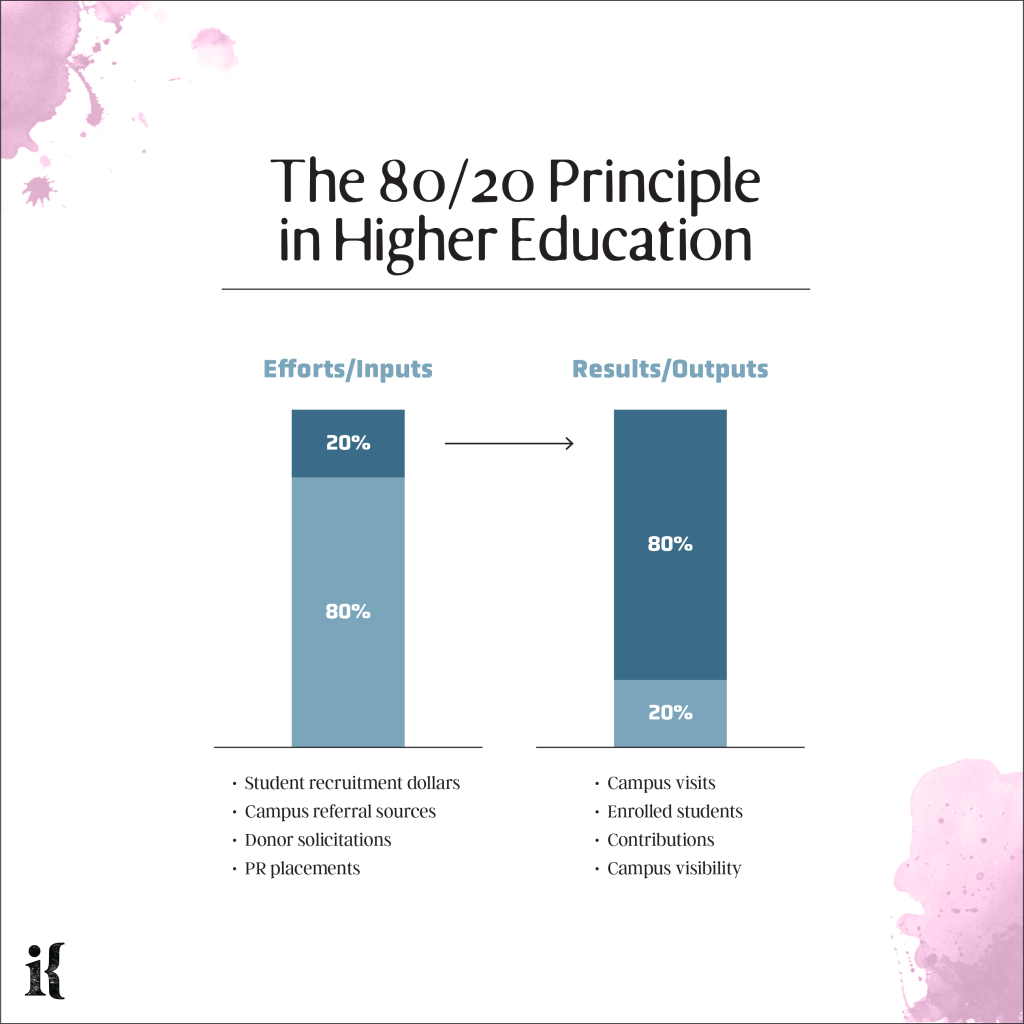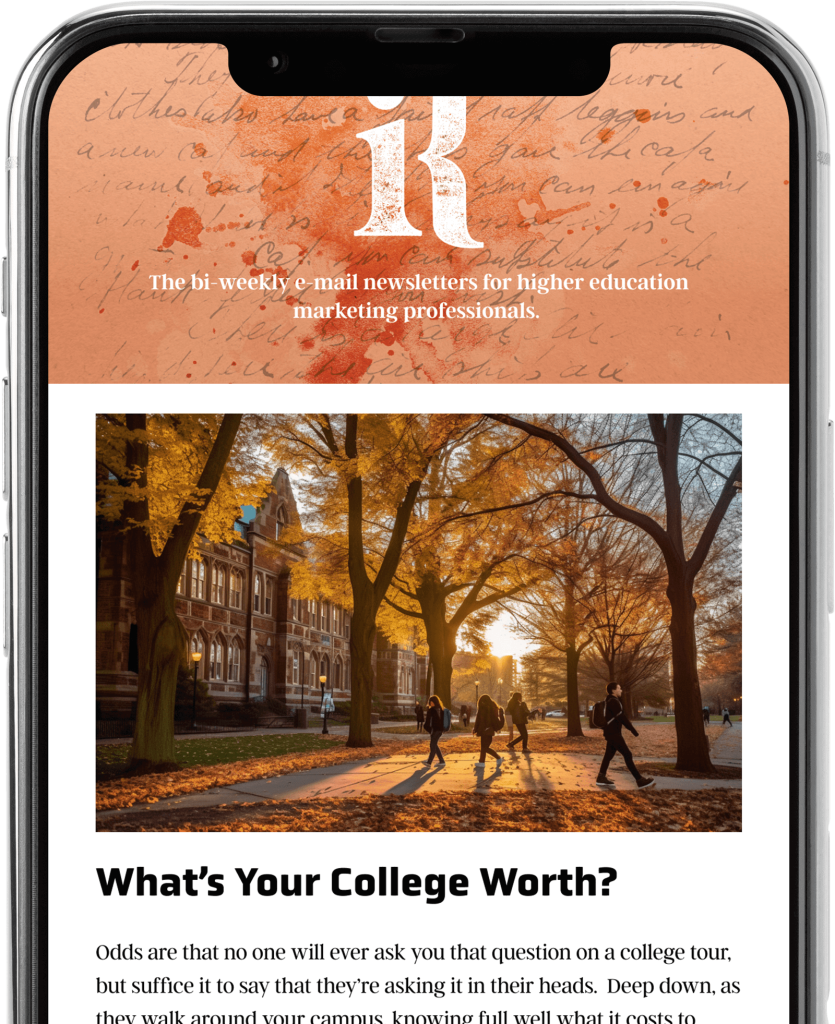Higher Education Marketing
The 80/20 Principle in Higher Education Marketing

The 80/20 Principle in Higher Education Marketing
Since we know that the power of the 80/20 Principle is evident so many walks of life, we can safely assume that its presence and impact in the world of higher education is well worth understanding and exploring. And since marketing is so much about understanding where to channel energy, dollars, and other resources—including time—higher education marketers would be wise to examine where inputs and outputs may be disproportionate. In each area, we should be asking two questions: (1) where should we be doubling down our energy into successful inputs (leveraging our 20% of high-output inputs) and (2) where should we pare back or eliminate some of our less successful inputs (re-thinking our 80% of low-output inputs)

Examining programs – In many ways, the majors and courses we offer are products. In the 80/20 way of thinking, 80% of our students would be in 20% of our academic majors. If you examine the distribution of majors at your institution you will likely see something similar to that figure: most of the students bunched up into a handful of majors. This may lead to some institutions trimming their list of majors to focus on the ones that have the most traction. Beyond that, it should cause marketing energy to flow to those majors where most of the students are. Those majors should be highlighted more often than others through faculty profiles, student success stories, and social media posts. Marquee products should receive marquee billing.
Referral sources – For those that find out about your school through a referral, whether that’s a current student, alumnus, or guidance counselor, it’s reasonable to assume that they came through a small number of sources. Malcolm Gladwell’s The Tipping Point illuminated the idea that there are a particular group of people—he calls them “mavens”—that have a particular bent toward sharing news and being listened to. Today, some might call them “influencers” but don’t let that deter you if you bristle at that notion. Whatever the era or medium (after all, Paul Revere used a horse and a loud voice when he told settlers the British were coming), you would be wise to understand who is sharing the good news about your school so you can pave the way for them do do more of it. Who are the 20% of your referral sources that are having 80% of the impact on your school?
Feeder high schools – It’s more than likely that 80% of your students come from 20% of your feeder high schools. How can you do more with the top of your list and pare back on the 80% of schools that are only graduating 20% of your next incoming class?
Media channels – Marketing attribution—the art and science of understanding which marketing activities produced which results—can be an even more useful tool when allocating media dollars that are being more stretched every year. It’s reasonable to assume that 20% of your media channels are driving 80% of your engagement and enrollment. Are you struggling to manage too many channels of communication with prospective students. It’s not uncommon to see a college linking to 7 or 8 social media channels when only 1 or 2 are getting real traction. Consider ditching those channels that aren’t helping in favor of focusing on the ones that are. If Pinterest suddenly surges with Gen Z one day, you can always re-visit it. For now, though, consider shutting it down and taking it off of your website. What are the 20% of your media channels driving 80% of engagement?
Messaging points – With all of the messages we are sending to prospective students, the 80/20 Principle can be useful to us in terms of understanding what areas of our messaging are truly making an impact. We can reasonably assume that 80% of what we are saying is having minimal impact in our recruitment messaging. In contrast, 20% of our messaging is carrying the day with 80% of our audience. How can we distill our messaging in a way that sheds some of the superfluous messaging and focused us instead on the messages that truly make an impact.
Alumni donations – Fundraising and development officers are typically adept at this kind of thinking already. Most capital campaigns, after all, are structured around a handful of donors contributing the lions share of dollars to lead a philanthropic initiative while the remaining capital is given in smaller amounts by a much broader group of contributors. The truth of the principle remains, though, in analyzing your list of donors and prospects: a disproportionately large amount of fundraising potential lies in a small number of philanthropists.
The 80/20 Principle has implications all through a college campus and certainly through the offices of marketing and development. Consider using it as an overlay to any challenge or opportunity when you are seeking to make a disproportionate impact on an outcome by harnessing a concentrated effort or expenditure of resources. It’s also important to note that the 80/20 Principle should never be used as a definitive guide to changing focus, eliminating programs, or otherwise. After all, some aspects of any institution’s composition that lie within that (perhaps lower performing) 80% might be important aspects of tradition, reputation, differentiation, or heritage and should be preserved or cultivated at all costs.
Like what you're reading?
Subscribe to our newsletter to get the latest insights in Higher Education and thought leadership.


